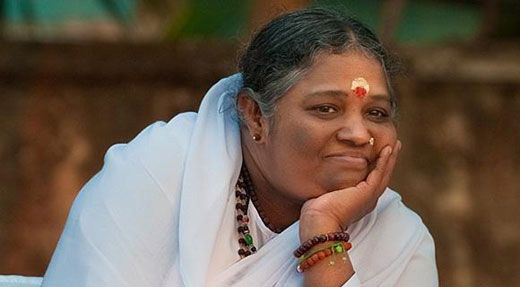by Clarissa Ward, ABC News: Amma attracts crowds of hundreds of thousands.

And more and more Americans are drawn to her simple message of love and acceptance and public service, leaving their lives behind to follow her all the way to the tiny village in southern India where she was born.
It’s 5 p.m. on a Saturday and Mata Amritanandamayi Devi has been hugging people for six hours. It will be midnight before she finishes for the day.
During that time she will not use the bathroom, will not stretch her legs, will not take a break to eat. She will simply hug.
Known as Amma, which means “mother,” Devi has hugged close to 30 million people around the world, earning her the nickname “the hugging saint” and making her a spiritual superstar.
When she is not traveling around the world, Amma lives in her ashram, or religious retreat, called Amritapuri, located in the same South Indian village where she was born into a poor fishing family 56 years ago.
As Amma’s fame has skyrocketed, Amritapuri has become a place of pilgrimage. As many as 5,000 people now live here and hundreds of thousands visit every year.
“It’s Amma’s heart that’s drawing everybody here. It’s like a mecca, a place of divine love,” said an American woman called Kusuma, who with her family is among the hundreds of Americans who spend much of the year here. Born Gretchen McGregor, Kusuma was first inspired to visit in 1983, after seeing a photograph of Amma.
“Her eyes were so alive,” said Kusuma. “I just couldn’t put her face out of my mind and I felt that I had to come to meet her. And when I told my family that they were a little bit shocked, they were like, ‘You’re going where to see who? What? Indiana?'”
Kusuma says her life changed forever when she saw Amma heal a person with leprosy.
“And I knew of course the story of Christ healing the leper, and I felt like something, um, that I couldn’t explain had happened, and I needed to understand it somehow. … And she looked at me like Amma does, you know, so simple and she said, ‘You want to know the miracle.’ And I said yes. And she said, ‘The real miracle is that you have the same power inside of you and you don’t know it.'”
Amma: ‘To Me She’s the Universe’
Life at Amritapuri is simple. People follow a vegetarian diet and there is no smoking or drinking. Residents are encouraged to participate in at least two hours of voluntary work, known as seva, every day. During free time, activities such as meditation, yoga and chanting are popular.
Gloria Sutton, who goes by her spiritual name, Kavya, has been following Amma for 14 years. “This is my first guru,” she said. “She has encouraged me to take further paths, further my spiritual life.”
Like many at Amritapuri, Kavya sees Amma as a divine being.
“Just recently I was in a very, very bad car crash in Southern California, and I passed to the other life. And I called out Amma’s name and I came back,” Kavya said. “To me she’s the universe and my mother, so she’s pretty awesome. She has the form of a woman but she’s way beyond this, way beyond.”
There are pictures of Amma everywhere you turn in Amritapuri: at cafes, in cupboards, on doors, even in elevators.
The local gift store is filled with Amma books, Amma rings, Amma watches, Amma CDs. There’s even a monthly Amma magazine which, much like Oprah Winfrey’s O, features Amma on every cover.
Californian Brian Harvey, known now as Gautam, was inspired to visit Amritapuri after hearing about Amma’s charitable works.
“It’s not so much that people see those pictures like we would see a poster of a movie star or something and think they’re physically attractive,” he said. “People look at Amma and they’re instantly reminded of all those good, positive qualities that they’re aspiring to invite more into their life.”
Amma’s organization funds hospitals, orphanages, a university and dozens of schools. She famously donated $46 million to victims of the Southeast Asian tsunami.
And she can afford to be generous. In 2008, Amma’s foundation raked in $78 million, most of which it claims is given away. The organization’s overhead costs are minimal, thanks in part to dedicated devotees like Gautam who work around the clock. Gautam and other volunteers are unpaid — in fact, they pay to stay at Amritapuri.
‘We’re Not Motivated Based on Any Income’
“We can stop working whenever we want, but we’re not motivated based on any income or anything, there’s no motives like that,” said Gautam. “We’re here on a voluntary basis and we’re serving out of the motivation to help other people.”
The highlight of life at Amritapuri is when Amma emerges to receive the tens of thousands of daily visitors and give out the hugs that have made her so famous.
As Amma takes her devotees in her arms, she inspires outpourings of emotions. Her Sari is stained with her admirers’ sweat and tears.
It seemed only fitting for a reporter to experience the famous hug first-hand.
There is no spiritual thunderbolt to speak of, but it’s certainly the nicest hug I’ve ever had from a stranger. It was warm and unrushed despite the long line. She whispered mantras and held me close like a child.
For first-time visitor Jaye Bryan, it’s a transformative experience, well worth the long journey from Florida.
“Just being enraptured by her face when she looked at me, we made eye-to-eye contact, face-to-face and it wasn’t just a hug, it was a connection, that connection I was looking for,” said Bryan.
It’s not just Amma’s hugs that are moving more and more Americans to visit Amritapuri. For many, India provides a welcome escape from the commercialism of the United States.
“I think for me, it was important for me to get out of my attachment box in the States,” said Bryan, “with all the luxuries around me, and sort of rip me into the bare minimal and have the cultural influence of the smells and the sounds and the people…”
Ever since the Beatles meditated on the banks of the Ganges in the 1970s, India has been a haven for the spiritually curious. It’s a land of gurus and godmen, swamis and saints.
In Amma’s home state of Kerala, the government has launched a massive campaign capitalizing on the growing popularity of spiritual tourism, dubbing itself “Gods’ own country.”
Beatific yogis beam down from billboards, promising to change your life in just six days.
Amma makes no such claims. When we were summoned for a rare opportunity to talk with her, she laughed off the suggestion that she is a saint.
‘No Matter What Culture, Love Is the Same’
“There’s no difference between creation and God,” Amma said through an interpreter. “It’s like the waves in the ocean … though the forms are different, they are one. Amma sees God in everything.”
Her humble living quarters are decorated with a picture of Jesus Christ, a menorah and a verse from the Koran.
“No matter what culture, love is the same,” Amma said. “Wherever you go in the world, honey is the same, it is sweet. Fire is the same, it gives heat.”
We asked Amma what makes her hug people.
“It’s like asking a river why it flows, or the sun why it gives light,” she replied. “It is Amma’s nature to give love.”
Amma said the same potential is within all of us, but “if honey is enclosed within a stone, how can we know its sweetness?”
Perhaps it’s that question that has inspired so many to come to Amritapuri: to leave their lives and devote themselves to this mystical being half a world away; to put their faith in something as simple as love, and the power of the human touch.








































